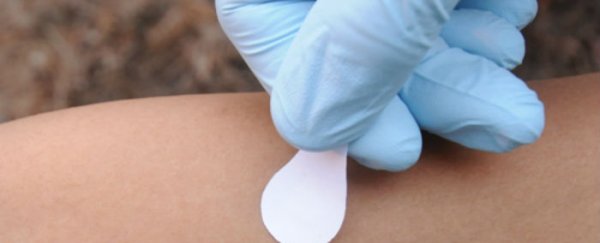If there's one thing the developing world needs better access to, it's vaccinations against diseases like measles, polio, and yellow fever. Because they're traditionally administered by injection, they require sterile environments and a trained professional to administer, plus constant refrigeration, all of which can get very expensive.
Researchers have been working for years on a better alternative to the needle, and we might finally be close to a viable solution - a little patch, covered in microneedles, that can be applied to the skin to deliver a painless dose of medication. Cheap to produce, easy to store, and requiring no medical professional to administer, these nifty little devices could change everything.
Developed by a team at Georgia Tech and the Centres for Disease Control and Prevention (CDC) in the US, the patches are about a square centimetre in size, and one side is lined with 100 solid, conical micro-needles made from polymer, sugar, and a vaccine drug. And when we say 'micro', we mean it - they're each only a fraction of a millimetre long.
When the patch is applied to the skin, the micro-needles are inserted into the upper layers of the skin before dissolving and releasing the vaccine. They're so close to being ready, the researchers expect to start clinical trials with a measles variety in 2017.
As Alexandra Ossola notes at Popular Science, while we've been hearing about vaccine patches for almost a decade now, this is about as close a we've seen the technology get to actually being a viable product. This is because of the challenges scientists have faced when trying to get the vaccination to permeate through the skin and into the blood stream - getting it to be as effective as just injecting it in there has been difficult.
"Georgia Tech researchers are not the only ones working on a vaccine patch, but they have long been at the forefront of this field," says Ossola. "The team recently completed another study in monkeys and found that their measles vaccine patch worked just as well as a vaccine administered by needles and had no adverse side effects."
According to the study, published in the journal Vaccine in March, their patch takes about 10 minutes to work for their monkey subjects, and effectively generated neutralising antibody responses to the measles virus. They were stored at a range of temperatures that would be realistic in various parts of the world, and reportedly held up fine.
"Each day, 400 children are killed by measles complications worldwide. With no needles, syringes, sterile water or sharps disposals needed, the microneedle patch offers great hope of a new tool to reach the world's children faster, even in the most remote areas," James Goodson, an epidemiologist at the CDC's Global Immunisation Division, said in a press release. "This advancement would be a major boost in our efforts to eliminate this disease, with more vaccines administered and more lives saved at less cost."
Let's hope they can do it.
